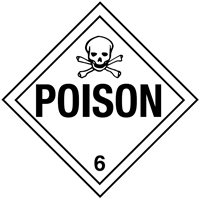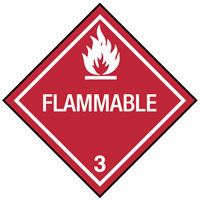
 Print
Print
Chemical Datasheet
FURFURAL |


|
Chemical Identifiers
| CAS Number |
UN/NA Number |
DOT Hazard Label |
USCG CHRIS Code |
- 98-01-1

|
|
|
|
| NIOSH Pocket Guide |
International Chem Safety Card |
|
Furfural
|
|
NFPA 704
General Description
Colorless or reddish-brown mobile liquids with a penetrating odor. Flash points 140°F. Denser than water and soluble in water. Vapors heavier than air. May be toxic by ingestion, skin absorption or inhalation.
Hazards
Reactivity Alerts
- Polymerizable
- Peroxidizable Compound
Air & Water Reactions
Flammable. This chemical is sensitive to light and air. Soluble in water, with mixing.
Fire Hazard
Special Hazards of Combustion Products: Irritating vapors are generated when heated (USCG, 1999)
Health Hazard
Vapor may irritate eyes and respiratory system. Liquid irritates skin and may cause dermatitis. (USCG, 1999)
Reactivity Profile
FURFURAL reacts with sodium hydrogen carbonate. It also can react with strong oxidizers. An exothermic resinification of almost explosive violence can occur upon contact with strong mineral acids or alkalis. It forms condensation products with many types of compounds, including phenol, amines and urea. (NTP, 1992).
Belongs to the Following Reactive Group(s)
- Aldehydes
- Ethers
- Hydrocarbons, Aliphatic Unsaturated
Potentially Incompatible Absorbents
Use caution: Liquids with this reactive group classification have been
known to react with the
absorbents
listed below.
- Cellulose-Based Absorbents
- Dirt/Earth
Response Recommendations
Isolation and Evacuation
Excerpt from ERG Guide 153

[Substances - Toxic and/or Corrosive (Combustible); polymerization hazard]:
IMMEDIATE PRECAUTIONARY MEASURE: Isolate spill or leak area in all directions for at least 50 meters (150 feet) for liquids and at least 25 meters (75 feet) for solids.
SPILL: Increase the immediate precautionary measure distance, in the downwind direction, as necessary.
FIRE: If tank, rail tank car or highway tank is involved in a fire, ISOLATE for 800 meters (1/2 mile) in all directions; also, consider initial evacuation for 800 meters (1/2 mile) in all directions. (ERG, 2024)
Firefighting
Excerpt from ERG Guide 153

[Substances - Toxic and/or Corrosive (Combustible); polymerization hazard]:
SMALL FIRE: Dry chemical, CO2 or water spray.
LARGE FIRE: Dry chemical, CO2, alcohol-resistant foam or water spray. If it can be done safely, move undamaged containers away from the area around the fire. Dike runoff from fire control for later disposal.
FIRE INVOLVING TANKS, RAIL TANK CARS OR HIGHWAY TANKS: Fight fire from maximum distance or use unmanned master stream devices or monitor nozzles. Do not get water inside containers. Cool containers with flooding quantities of water until well after fire is out. Withdraw immediately in case of rising sound from venting safety devices or discoloration of tank. ALWAYS stay away from tanks in direct contact with flames. (ERG, 2024)
Non-Fire Response
Excerpt from ERG Guide 153

[Substances - Toxic and/or Corrosive (Combustible); polymerization hazard]:
ELIMINATE all ignition sources (no smoking, flares, sparks or flames) from immediate area. Do not touch damaged containers or spilled material unless wearing appropriate protective clothing. Stop leak if you can do it without risk. Prevent entry into waterways, sewers, basements or confined areas. Absorb or cover with dry earth, sand or other non-combustible material and transfer to containers. DO NOT GET WATER INSIDE CONTAINERS. (ERG, 2024)
Protective Clothing
Excerpt from NIOSH Pocket Guide for Furfural:
Skin: PREVENT SKIN CONTACT - Wear appropriate personal protective clothing to prevent skin contact.
Eyes: PREVENT EYE CONTACT - Wear appropriate eye protection to prevent eye contact.
Wash skin: WHEN CONTAMINATED - The worker should immediately wash the skin when it becomes contaminated.
Remove: WHEN WET OR CONTAMINATED - Work clothing that becomes wet or significantly contaminated should be removed and replaced.
Change: No recommendation is made specifying the need for the worker to change clothing after the workshift. (NIOSH, 2024)
DuPont Tychem® Suit Fabrics
Normalized Breakthrough Times (in Minutes)
| Chemical |
CAS Number |
State |
QS |
QC |
SL |
C3 |
TF |
TP |
RC |
TK |
RF |
| Furaldehyde, 2- |
98-01-1 |
Liquid |
|
|
198*/227 |
>480 |
>480 |
>480 |
>480 |
>480 |
>480 |
| Furfural |
98-01-1 |
Liquid |
|
|
198*/227 |
>480 |
>480 |
>480 |
>480 |
>480 |
>480 |
Special Warning from DuPont: Tychem® and Tyvek® fabrics should not be
used around heat, flames, sparks or in potentially flammable or
explosive environments. Only...
(DuPont, 2024)
First Aid
EYES: First check the victim for contact lenses and remove if present. Flush victim's eyes with water or normal saline solution for 20 to 30 minutes while simultaneously calling a hospital or poison control center. Do not put any ointments, oils, or medication in the victim's eyes without specific instructions from a physician. IMMEDIATELY transport the victim after flushing eyes to a hospital even if no symptoms (such as redness or irritation) develop.
SKIN: IMMEDIATELY flood affected skin with water while removing and isolating all contaminated clothing. Gently wash all affected skin areas thoroughly with soap and water. IMMEDIATELY call a hospital or poison control center even if no symptoms (such as redness or irritation) develop. IMMEDIATELY transport the victim to a hospital for treatment after washing the affected areas.
INHALATION: IMMEDIATELY leave the contaminated area; take deep breaths of fresh air. IMMEDIATELY call a physician and be prepared to transport the victim to a hospital even if no symptoms (such as wheezing, coughing, shortness of breath, or burning in the mouth, throat, or chest) develop. Provide proper respiratory protection to rescuers entering an unknown atmosphere. Whenever possible, Self-Contained Breathing Apparatus (SCBA) should be used; if not available, use a level of protection greater than or equal to that advised under Protective Clothing.
INGESTION: If the victim is conscious and not convulsing, give 1 or 2 glasses of water to dilute the chemical and IMMEDIATELY call a hospital or poison control center. Generally, the induction of vomiting is NOT recommended outside of a physician's care due to the risk of aspirating the chemical into the victim's lungs. However, if the victim is conscious and not convulsing and if medical help is not readily available, consider the risk of inducing vomiting because of the high toxicity of the chemical ingested. Ipecac syrup or salt water may be used in such an emergency. IMMEDIATELY transport the victim to a hospital. If the victim is convulsing or unconscious, do not give anything by mouth, ensure that the victim's airway is open and lay the victim on his/her side with the head lower than the body. DO NOT INDUCE VOMITING. IMMEDIATELY transport the victim to a hospital.
OTHER: Since this chemical is a known or suspected carcinogen you should contact a physician for advice regarding the possible long term health effects and potential recommendation for medical monitoring. Recommendations from the physician will depend upon the specific compound, its chemical, physical and toxicity properties, the exposure level, length of exposure, and the route of exposure. (NTP, 1992)
Physical Properties
Flash Point:
140°F
(NTP, 1992)
Lower Explosive Limit (LEL):
2.1 %
(NTP, 1992)
Upper Explosive Limit (UEL):
19.3 %
(NTP, 1992)
Autoignition Temperature:
739°F
(USCG, 1999)
Melting Point:
-33.7°F
(NTP, 1992)
Vapor Pressure:
1 mmHg
at 68°F
; 3 mmHg at 86°F; 10 mmHg at 122°F
(NTP, 1992)
Vapor Density (Relative to Air):
3.31
(NTP, 1992)
- Heavier than air; will sink
Specific Gravity:
1.159
at 68°F
(USCG, 1999)
- Denser than water; will sink
Boiling Point:
323.1°F
at 760 mmHg
(NTP, 1992)
Molecular Weight:
96.09
(NTP, 1992)
Water Solubility:
50 to 100 mg/mL
at 64°F
(NTP, 1992)
Ionization Energy/Potential:
9.21 eV
(NIOSH, 2024)
IDLH:
100 ppm
(NIOSH, 2024)
AEGLs (Acute Exposure Guideline Levels)
No AEGL information available.
ERPGs (Emergency Response Planning Guidelines)
| Chemical |
ERPG-1 |
ERPG-2 |
ERPG-3 |
|---|
| Furfural (98-01-1)
|
2 ppm  |
10 ppm |
50 ppm |
(AIHA, 2022)
PACs (Protective Action Criteria)
| Chemical |
PAC-1 |
PAC-2 |
PAC-3 |
|
| Furancarboxaldehyde, 2-; (Furfural) (98-01-1)
|
2 ppm |
10 ppm |
100 ppm |
LEL = 21000 ppm |
(DOE, 2024)
Regulatory Information
EPA Consolidated List of Lists
| Regulatory Name |
CAS Number/
313 Category Code |
EPCRA 302
EHS TPQ |
EPCRA 304
EHS RQ |
CERCLA RQ |
EPCRA 313
TRI |
RCRA
Code |
CAA 112(r)
RMP TQ |
| Furfural |
98-01-1 |
|
|
5000 pounds |
|
U125 |
|
(EPA List of Lists, 2024)
CISA Chemical Facility Anti-Terrorism Standards (CFATS)
No regulatory information available.
OSHA Process Safety Management (PSM) Standard List
No regulatory information available.
Alternate Chemical Names
- ALPHA-FUROLE
- ARTIFICIAL ANT OIL
- ARTIFICIAL OIL OF ANTS
- 2-FORMYLFURAN
- FURAL
- FURAL/PYROMUCIC ALDEHYDE
- FURALDEHYDE
- 2-FURALDEHYDE
- FURALE
- 2-FURANALDEHYDE
- 2-FURANCARBALDEHYDE
- FURANCARBONAL
- 2-FURANCARBONAL
- 2-FURANCARBOXALDEHYDE
- FURFURAL
- 2-FURFURAL
- FURFURALDEHYDE
- 2-FURFURALDEHYDE
- FURFURALDEHYDES
- FURFUROL
- FURFUROLE
- FURFURYLALDEHYDE
- FUROLE
- 2-FURYLALDEHYDE
- 2-FURYLCARBOXALDEHYDE
- 2-FURYLMETHANAL
- NCI-C56177
- PYROMUCIC ALDEHYDE
- QUAKERAL
- U1199



 Print
Print

